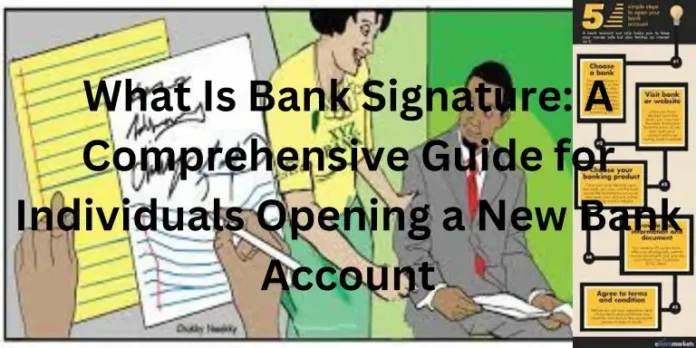Are you opening a new bank account and curious about the concept of a bank signature? In this comprehensive guide, we will explore the ins and outs of bank signatures, their importance, and how they are applied in real-life scenarios. Whether you’re a novice or have some understanding of bank signature verification, this article will provide you with valuable insights and practical examples to enhance your knowledge.
Introduction: Understanding the Basics of Bank Signatures
When opening a new bank account, you may have come across the term “bank signature” or “signature verification.” But what exactly does it mean? In simple terms, a bank signature refers to the act of signing your name on various financial documents to authorize transactions or verify your identity.
The Importance of Bank Signatures
Bank signatures play a crucial role in ensuring the security and authenticity of financial transactions. They serve as a unique identifier, allowing banks to verify the identity of the account holder and detect any fraudulent activities. By comparing the signature on a document with the signature on file, banks can confirm that the account holder has authorized the transaction.
How Bank Signatures Are Applied in Real-Life Scenarios
Let’s explore some real-life scenarios where bank signatures are commonly used:
1. Opening a New Bank Account
When you decide to open a new bank account, one of the initial steps is to sign various account opening documents. Your signature on these documents serves as an agreement to abide by the bank’s terms and conditions, as well as a means to verify your identity.
2. Depositing or Withdrawing Funds
When making a deposit or withdrawal at a bank branch, you will be required to sign the relevant transaction slip or withdrawal form. Your signature on these documents authorizes the bank to carry out the requested transaction and ensures that only authorized individuals have access to your funds.
3. Writing Checks
Writing a check involves signing your name on the designated line at the bottom of the check. This signature acts as a verification method, confirming that you have authorized the payment to the recipient.
4. Loan Applications
When applying for a loan, you will need to sign loan documents that outline the terms and conditions of the loan. Your signature on these documents signifies your agreement to repay the loan and allows the bank to proceed with the lending process.
5. Credit Card Applications
Similar to loan applications, credit card applications require your signature to authorize the issuance of a credit card. By signing the application form, you confirm your agreement to the terms and conditions set by the credit card issuer.
Tools, Software, and Services for Verifying Bank Signatures
To ensure the accuracy and efficiency of bank signature verification, various tools, software, and services are available. Here are a few examples:
1. Signature Verification Software
Banks often utilize signature verification software to compare signatures on documents with the account holder’s signature on file. This software uses advanced algorithms and artificial intelligence to analyze and authenticate signatures, reducing the risk of fraud.
2. Biometric Authentication
Some banks have implemented biometric authentication methods, such as fingerprint or facial recognition, to enhance the security of signature verification. These technologies provide an additional layer of protection against unauthorized access to accounts.
3. Signature Cards
In some cases, banks maintain signature cards for their account holders. These cards contain multiple samples of the account holder’s signature, which can be used for comparison during signature verification processes.
4. Manual Verification by Bank Staff
Despite technological advancements, manual verification by trained bank staff remains an essential component of signature verification. Trained personnel compare signatures on documents with the account holder’s signature on file, ensuring accuracy and minimizing the risk of false positives or negatives.
Enhancing Bank Signature Verification: Best Practices
To ensure the effectiveness of bank signature verification, both banks and individuals can follow these best practices:
1. Consistency: Maintain consistency in your signature across different documents to avoid confusion during verification processes.
2. Signature Updates: If you decide to change your signature, notify your bank to update their records accordingly. This will prevent any discrepancies during verification.
3. Secure Signature Storage: Banks should prioritize the secure storage of signature records to prevent unauthorized access or tampering.
4. Regular Training: Banks should provide regular training to their staff on signature verification techniques and the latest advancements in technology.
Statistical Data on Bank Signature Verification
Here are some relevant statistics that shed light on the importance and usage of bank signatures:
– According to a survey conducted by the American Bankers Association, 90% of banks consider signature verification as an essential part of their fraud prevention measures.
– The Federal Reserve reported that in 2020, there were approximately 15,700 cases of check fraud, highlighting the significance of robust signature verification processes.
Conclusion
In conclusion, a bank signature is a vital component of financial transactions, serving as a means to verify identity and authorize transactions. Whether you’re opening a new bank account, depositing funds, or applying for a loan, your signature plays a crucial role in ensuring the security and authenticity of these transactions. By understanding the importance of bank signatures and following best practices, individuals and banks can enhance the effectiveness of signature verification processes, minimizing the risk of fraud and unauthorized access to accounts.


